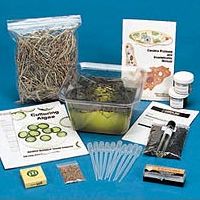My Cart
Your Shopping Cart is currently empty. Use Quick Order or Search to quickly add items to your order!

By Melissa Hodges
Product Manager, Zoology, Microbiology, and Botany
Carolina Biological Supply Company
When asked to picture a local ecosystem, your students are likely to think of conspicuous animals and plants, but they may not consider the microscopic organisms found in freshwater sources. While it may be inconvenient to take students to sample ponds and streams, you can easily re-create an exciting and diverse aquatic community in your classroom. Students can observe, sample, and test the ecosystem for as long as you care to keep it. If you do not have time to collect a balance of aquatic producers and consumers and set them up in a small tank, try the Carolina™ Minipond Ecosystem Kit. This kit provides opportunity for students to identify many typical aquatic organisms and to study the habitat as a whole. You can incorporate this model ecosystem into a variety of topics:
After you create a minipond, your students can observe and sample it just as if they were visiting a local pond or stream. Have them get a drop of pond water with a pipet, add it to a microscope slide, and cover it with a coverslip. If they find that some protozoans move too fast to be observed clearly under the microscope, they can add a drop of Protoslo® Quieting Solution to the next slide before covering it. Protoslo® does not harm the organisms, but its viscosity slows their movement enough to keep them in focus and in the field of view. Students can then observe their structures and their method of locomotion.
Challenge students to sketch 3 to 5 different organisms in enough detail that the sketches can be used later for identification. Students can compare their sketches and see what others are seeing. To help students identify the various microorganisms, download our free illustrated key to common freshwater microorganisms.
Need to make your activities using microorganism cultures easier? Here are a few quick ideas.